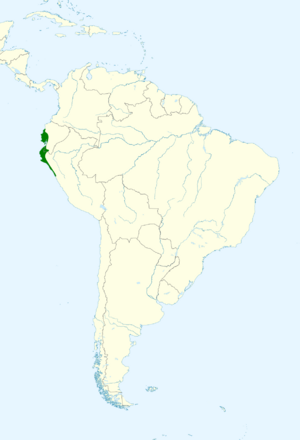Superciliated wren facts for kids
Quick facts for kids Superciliated wren |
|
|---|---|
 |
|
| Conservation status | |
| Scientific classification | |
| Genus: |
Cantorchilus
|
| Species: |
superciliaris
|
 |
|
| Synonyms | |
|
Thryothorus superciliaris |
|
The Superciliated Wren (scientific name: Cantorchilus superciliaris) is a small bird that belongs to the wren family, Troglodytidae. You can find this bird living in the countries of Ecuador and Peru.
Contents
Understanding the Superciliated Wren
Scientists sometimes thought the Superciliated Wren was the same species as another bird called the Buff-breasted Wren. However, they sing different songs and live in different places. This shows they are actually separate species.
The Superciliated Wren has two main types, called subspecies. These are C. s. superciliaris and C. s. baroni.
What the Superciliated Wren Looks Like
This wren is about 14.5 cm (5.7 in) long. Adult birds of the first type, C. s. superciliaris, have a dark grayish-brown top of the head. Their shoulders and back are a reddish-brown color, which gets even redder near their tail. Their tail is reddish-brown with black stripes.
They have a bright white stripe above their eye, called a supercilium. There is also a dark brown stripe that goes through their eye. Their cheeks are a light, creamy white color. The chin and throat are also pale creamy white. This color gets darker on their lower chest. The sides of their body are a grayish-cream color.
Young Superciliated Wrens look similar to adults. However, their upper parts are a cooler brown color. The other type, C. s. baroni, has a more yellowish-brown lower back and rump.
Where the Superciliated Wren Lives
The C. s. superciliaris type of Superciliated Wren lives in western Ecuador. You can find them from Manabí Province down to Guayas Province.
The C. s. baroni type lives further south. They are found from southern Ecuador's El Oro and Loja Provinces. Their home range extends south into the Ancash and Lima areas of west-central Peru.
These birds mostly live in dry woodlands, scrub, and bushy areas. They can also be found in woodlands that are a bit more humid. They usually live from sea level up to about 1,500 m (4,900 ft) high. Sometimes, they can be found as high as 1,850 m (6,070 ft).
Superciliated Wren Behavior
How They Find Food
Superciliated Wrens look for food in plants, both on the ground and close to it. They usually search for food in pairs. Their main food source seems to be insects.
Reproduction and Nests
We don't know a lot about when Superciliated Wrens breed. We do know they breed in January and February in Peru. Their nest is shaped like a flask and is not very strong.
A pair of wrens will build several nests. However, they only use one of these nests for laying eggs and raising their young. The nest they choose is lined with soft materials. Nests are usually placed about 1.6 to 3.2 m (5.2 to 10.5 ft) above the ground in a bush or a tree. The female bird lays two or three eggs. Sadly, their nests are often taken over by Shiny Cowbirds (Molothrus bonariensis). These cowbirds lay their own eggs in the wren's nest for the wrens to raise.
How They Sing
Both male and female Superciliated Wrens are thought to sing. Their song is described as "a series of short repeated phrases of 2 or 3 notes." Sometimes, they add a trill to their song.
Conservation Status
The IUCN (International Union for Conservation of Nature) has looked at the Superciliated Wren. They have decided that this bird is of "Least Concern." This means it is not currently in danger of disappearing. The bird is common in some parts of its home range. It also seems to be able to live in places where humans have changed the habitat a little bit.


